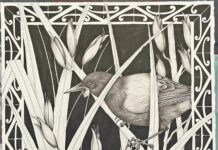Rucksacks, walking boots, rain, rasping possum coughs, blisters, sore legs, playing cards, endless water boiled for cups of tea, a cask of wine, vodka and lime, arguments, stark home truths, dark secrets revealed, a hut ghost and plenty of drunken fun and games, are all part of Waiheke Theatre Company’s latest production of Roger Hall’s Social Climbers, which opens tonight, Thursday 18 August at Artworks Theatre in Oneroa.
This award-winning play was originally written in 1995, but was updated in 2015.
Over the past couple of years, when overseas travel has been either impossible or very difficult, New Zealanders have spent more time than ever before exploring their own backyard.
Even more people became familiar with Department of Conservation huts, which enable trampers to explore the more remote areas of New Zealand. The Department of Conservation manages a network of more than 950 huts and without this iconic accommodation, many of the most scenic parts of New Zealand would be lost to the general public.
Director Lucinda Peterken has visited many such huts on numerous tramping trips, and says styles and sizes vary from little more than a dry roof over your head and space to sleep just a few people, to large modern huts with gas hobs, barbecues and bunks that can sleep 120 people.
While the huts themselves vary enormously, the habits and etiquette of those who stay in them do not. Some of these are behaviours developed from ‘rules’ that are clearly stated on the walls of the hut, and some are just ‘absorbed’ by newbies from those experienced in the art of hut etiquette. In the summer months there is often a warden who makes sure no boots are brought inside the hut, that the mattresses are all upended on the bunks, floors are swept, fires cleaned, wood replaced and kitchen areas spotless when the last tramper heads off in the morning.
The experienced ‘hutter’ will make sure others know he or she has done this many times by being the first to get the fire going, regardless of the outside temperature, by always being one of the first to arrive so they can take ownership of the best bunk spot by getting their mattress down and laying out their sleeping bag. They will have a cup of tea in their hands and a home-baked slice, looking like they have been there for hours by the time the next person arrives.
Those who arrive last, usually limping in with blisters and sore knees, receive smug smiles of welcome as they go to find the last available (top) bunk right by the door, beside a draughty window. The snorers get huffed and puffed at by those trying to cover the sounds with their sleeping bags, but never is it mentioned in the morning.
Getting the latest weather update is critical and many a happy tramper has had their hut stay extended due to bad weather causing rivers to rise or flood, bridges to be washed away, or snow creating a dangerous whiteout.







